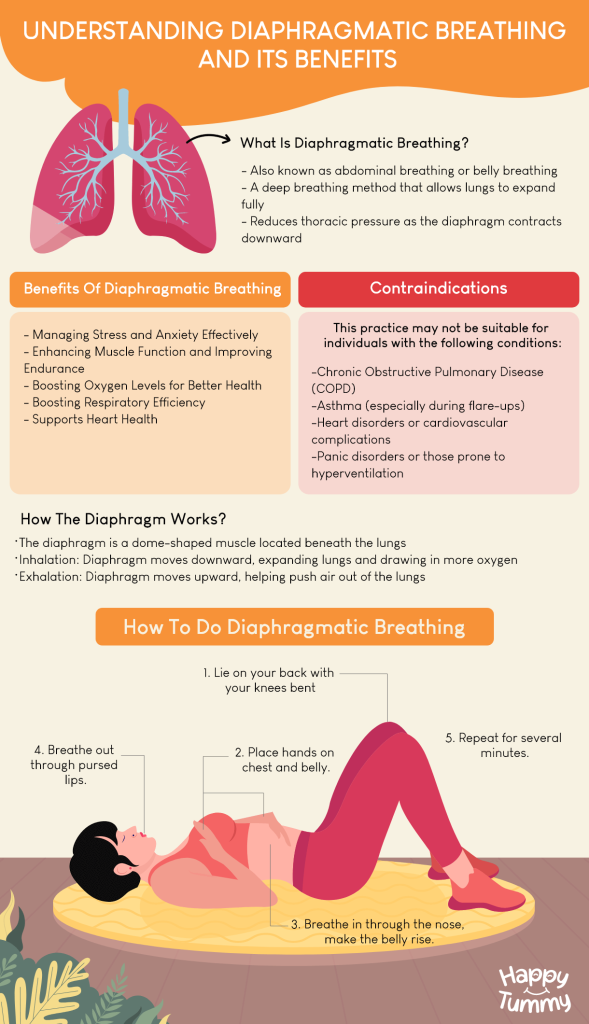Table of Contents
Did you know that the way you breathe can drastically affect your well-being?
Have you ever thought of whether there is a better way to breathe so that you could relieve stress, enhance your concentration, and even give you more energy?
The solution is a method referred to as diaphragmatic breathing, also known as belly breathing. Living in a world of rush and hurry, one can always take a deep breath, regain one’s sense of balance, calm one’s mind, and re-establish one’s energy.
In contrast to shallow breathing, which is the breathing style used by the majority of us, diaphragmatic breathing utilises the diaphragm, enabling deeper and more complete breathing.
The method causes air to pass deep into the lungs, encouraging appropriate oxygen flow.
The positive effects are not only limited to supporting the management of stress and anxiety levels, but also might help lung function and circulation.
So, without further ado, let us explore how one can begin taking advantage of the benefits of diaphragmatic breathing by including it in daily life.
What is Diaphragmatic Breathing?
Diaphragmatic breathing (also called abdominal breathing or belly breathing) is a method of deep breathing that allows the lungs to expand more fully by reducing thoracic pressure when the diaphragm contracts downward.
The diaphragm is the big muscle that is shaped like a dome and is found under your lungs. It is essential to regulate your breathing by expanding and contracting with every intake and exhalation of air.
As you breathe in, the diaphragm moves downward, allowing your lungs to expand and take in more oxygen.[1]
When you exhale, the diaphragm relaxes and moves upward, helping push air out of the lungs. All of us, as babies, breathe this way, but as we mature, we tend to adopt shallow chest breathing, especially when we are feeling stressed.

How to Do Diaphragmatic Breathing
Diaphragmatic breathing is easy to practice and can be done at any time and in any place, but it’s best to begin in a comfortable position.
This practice will become easier with time, and you can incorporate diaphragmatic breathing while sitting or standing, making it a convenient tool to apply in your everyday life. Taking a lot of deep, slow breaths can help you feel relaxed, more energised, and calmer.
Please note that some minimal chest movement may still occur even during ideal diaphragmatic breathing, especially in individuals with specific anatomies or mild anxiety.
Below is the step-by-step breathing exercise flow:
Lie on your back with your knees bent
⬇
Place hands on chest and belly.
⬇
Breathe in through the nose, make the belly rise.
⬇
Breathe out through pursed lips.
⬇
Repeat for several minutes.
Benefits of Diaphragmatic Breathing
Diaphragmatic breathing offers numerous health benefits to both the body and the mind.
Some of the most significant advantages of incorporating this simple yet powerful method into your daily routine are outlined below.
#1 Managing Stress and Anxiety Effectively
Diaphragmatic breathing can be beneficial in managing stress and anxiety. When we are stressed, our bodies enter the fight-or-flight response, and as a result, we breathe shallowly and rapidly. This may speed up the heart rate and tighten muscles (because every stress response is different).
However, this breathing technique involves paying attention to slow, deep, and controlled breaths, which triggers the parasympathetic nervous system and creates a relaxing effect. [2]
Research has found that deep and slow breathing, along with mindfulness and aerobic exercise, can help manage cortisol levels, anxiety and even stabilise the heart rate.[3]
This is the effective way out of the stress loop, bringing the body and mind back to the state of calmness, strengthening emotional stability, and generally managing stress.[4]
#2 Enhancing Muscle Function and Improving Endurance
Diaphragmatic breathing plays a crucial role in enhancing muscle activity during exercise. It aids in the distribution of oxygen to your muscles, enables you to endure longer, and helps manage fatigue by supporting posture and core. [5]
This is because adequate oxygenation maintains the muscles with the energy necessary to perform at a sustained effort, thus avoiding muscle strain.[6]
The core is also stabilised by breathing deeply, which provides good posture and support to the spine.
The technique may help you maximise your physical performance while also avoiding overexertion.
#3 Boosting Oxygen Levels for Better Health
Diaphragmatic breathing may enhance blood oxygenation, leading to improved health and performance. During diaphragmatic breathing, the air reaches the lower part of the lungs, unlike shallow breathing, which only fills the upper part of the lungs.
This improves air distribution to the alveoli in the lower lungs, enhancing oxygen exchange efficiency.[7]
More oxygen helps the brain function better, generate energy, and improve muscle performance.
Constant diaphragmatic breathing will keep your body well supplied with oxygen, which it needs to be able to perform at its best, both physically and mentally.[8]
#4 Boosting Respiratory Efficiency
Diaphragmatic breathing may also enhance the body’s performance in eliminating one of the major metabolic wastes, carbon dioxide, from the lungs. It helps make your diaphragm stronger and could improve how efficiently your lungs work over time.[9]
This enlarged lung volume makes it easier to get rid of the carbon dioxide and enhances respiration as a whole.
Studies have shown that diaphragmatic breathing helps strengthen the diaphragm and lungs, thereby facilitating a more effective exhalation process. [10]
#5 Supports Heart Health
The diaphragmatic breathing technique may be a valuable method of supporting healthy blood pressure levels. It triggers the parasympathetic nervous system, thereby stimulating a relaxed state that alleviates stress that may increase blood pressure. [11]
Studies indicate that slow and deep breathing exercises, along with weight management, can help reduce both systolic and diastolic blood pressure by relaxing and improving blood circulation.[12]
Diaphragmatic breathing may also help improve heart performance by increasing the amount of oxygen taken into the body.
Tips to Get Started and Keep Going with Diaphragmatic Breathing
Learning to breathe diaphragmatically is not as complicated as it might sound, and, as with all new things, it takes some time and dedication. With a couple of easy tricks integrated into your life, you will be able to start enjoying the full potential of this relaxing and energising practice.
1. Establish a Regular Programme: Make it a habit by trying to exercise at the same time every day. Find a quiet, comfortable place where you can concentrate without distractions.
2. Be Kind to Yourself and Start Small: Do not worry about doing it perfectly and how many minutes per day you take a breath. It is not to achieve perfection but progress. And, in case you skip a session or don’t feel like you’re breathing enough, simply resume it next time.
3. Clear Your Mind and Focus: Be aware of what you are breathing in and out, and the silence of everything around you. Once the thoughts begin to cross your mind, please recall to yourself the air that enters and goes out of the lungs.
4. Start with Short Sessions: Initially, aim for 10-20 minutes. Being consistent is the key, and not going overboard. You will discover that diaphragmatic breathing will get easier and natural as you form a habit.
5. Make It Part of Your Day: Explore the possibility of including diaphragmatic breathing in other daily practices. You can train even while sitting at your desk, before an exercise session, or even when watching TV. After building a habit, you can use this tool anytime when you have to collect your thoughts or relax a bit.
6. Use It During Key Moments: This technique can be beneficial during yoga sessions, before public speaking, or even right before an exam to reduce anxiety and improve mental clarity.
Contraindications
This practice may not be suitable for individuals with the following conditions:
- Chronic Obstructive Pulmonary Disease (COPD)
- Asthma
- Heart disorders or cardiovascular complications
- Panic disorders or those prone to hyperventilation
Note: Always consult a healthcare professional before beginning any new breathing or physical practice, especially if you have pre-existing medical conditions.
The Takeaway
Diaphragmatic breathing is an excellent, yet easy-to-practice method that can significantly improve your mood and overall health. It may help you handle stress, enhance the activity of your muscles, boost the level of oxygen, and even care for your heart.
With frequent practice, you will be able to relax, become energised, and gain control over your body.
Nevertheless, we should not forget that although diaphragmatic breathing may offer numerous advantages, it cannot replace medical treatment for some underlying health issues.
A breathing program is new, so it may be risky if you have respiratory or cardiovascular issues; therefore, consult a medical expert first. Make sure that you establish a personal health plan that suits you best.
Frequently Asked Questions
Diaphragmatic breathing could also be called:
· Abdominal breathing.
· Belly breathing.
After only a few sessions, many can already feel the strong effects of decreased stress levels and a feeling of calm. Nevertheless, to have longer-lasting results, such as enhanced lung capacity, stronger diaphragm, or better concentration, it usually requires some regular practice—a few weeks to be precise. The secret is consistency. Try to practice every day for at least 10-15 minutes.
Initially, do this exercise for 5 to 10 minutes, two times a day. The more you do this exercise, the more time you should spend doing it, and it may also become more challenging, such as placing a book over your abdomen.















